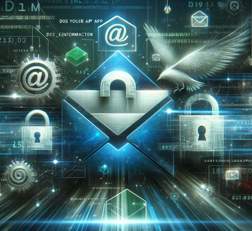| Ensuring Email Security |
| Written by Gilad David Maayan | |||
| Friday, 05 April 2024 | |||
Page 2 of 2
Email Security Best Practices for DevelopersHere are a few ways you can protect emails sent and received by your applications. Implementing TLS/SSL for Email TransmissionTransport Layer Security (TLS) and its predecessor, Secure Sockets Layer (SSL), are cryptographic protocols designed to provide communications security over a computer network. They are used to secure email transmissions, protecting the data during the transfer process. Implementing TLS/SSL for email transmission is the first step towards securing your email communication. This protocol ensures that the connection between the email server and the client is encrypted, making it difficult for hackers to intercept or tamper with the data. To implement TLS/SSL, you must first obtain a certificate from a Certificate Authority (CA). This certificate is then installed on your email server. Once the certificate is installed, you can configure your email server to use TLS/SSL for email transmission. When TLS/SSL is properly implemented, it provides a secure channel for transmitting emails, protecting them from eavesdropping and tampering. However, it's important to remember that TLS/SSL only secures the transmission of emails and not their storage or handling once they have been delivered. Role-Based Access Control (RBAC) for Email SystemsRole-Based Access Control (RBAC) is a system that restricts network access based on the roles of individual users within an organization. RBAC is an effective way to ensure that only authorized individuals have access to your organization's email system. With RBAC, you can define roles based on job functions and assign permissions to these roles. For instance, an employee in the human resources department would have a different set of permissions compared to an employee in the IT department. This way, each employee only has access to the information they need to perform their duties. Implementing RBAC for email systems is a best practice that can significantly enhance your email security. It reduces the risk of data breaches by limiting access to sensitive information. Moreover, it ensures accountability as each action performed in the system can be traced back to a specific user. Data Masking and EncryptionData masking and encryption are two more techniques for securing email content. Data masking is the process of replacing sensitive data with fictitious data. Encryption transforms data into a coded form, making it unreadable to anyone without the decryption key. Data masking is particularly useful when you need to use real data for testing or training purposes. Instead of using actual sensitive data, you can use masked data, reducing the risk of data exposure. Encryption is a must-have for any email security strategy. By encrypting your emails, you can ensure that even if they get intercepted during transmission, the content remains unreadable to unauthorized individuals. Implementing Automated Alerts for Suspicious ActivitiesThe ability to detect and respond to suspicious activities quickly is critical in preventing data breaches. Implementing automated alerts for suspicious activities in your email system can significantly enhance your email security. Automated alerts work by monitoring the email system for unusual activities and sending an alert when such activities are detected. For instance, if an account is sending out a large number of emails in a short period, it could be an indication of a compromised account. Automated alerts not only help in detecting potential threats but also in responding to them quickly. Upon receiving an alert, the security team can immediately investigate the issue and take the necessary actions to mitigate the threat.
Securing email is not a one-time effort but a continuous process. The threat landscape is constantly evolving, and so should your email security practices. By implementing these best practices, you can ensure a robust email security posture for your organization. More InformationRelated ArticlesUsing ABAC To Secure Your Applications How To Implement 2FA In Your Applications Web Service Security: What You Should Know Six Tools To Protect Your Web Applications Five Tips For Securing GitOps Environments Secure Coding Best Practices for 2022 To be informed about new articles on I Programmer, sign up for our weekly newsletter, subscribe to the RSS feed and follow us on Twitter, Facebook or Linkedin.
|

